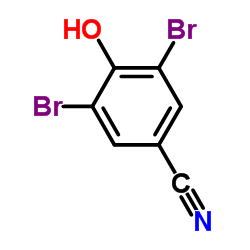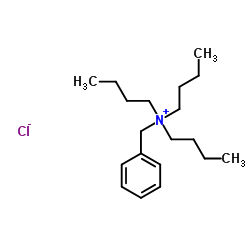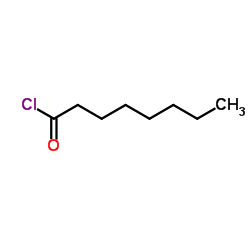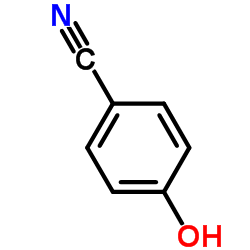2,6-Dibromo-4-cyanophenyl octanoate
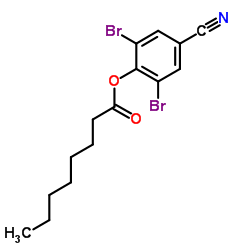
2,6-Dibromo-4-cyanophenyl octanoate structure
|
Common Name | 2,6-Dibromo-4-cyanophenyl octanoate | ||
|---|---|---|---|---|
| CAS Number | 1689-99-2 | Molecular Weight | 403.109 | |
| Density | 1.5±0.1 g/cm3 | Boiling Point | 424.6±45.0 °C at 760 mmHg | |
| Molecular Formula | C15H17Br2NO2 | Melting Point | 45-46°C | |
| MSDS | USA | Flash Point | 210.6±28.7 °C | |
| Symbol |



GHS06, GHS08, GHS09 |
Signal Word | Danger | |
Use of 2,6-Dibromo-4-cyanophenyl octanoateBromoxynil octanoate is an herbicide widely applied to maize, is potentially toxic to both animals and humans[1]. |
| Name | bromoxynil octanoate |
|---|---|
| Synonym | More Synonyms |
| Description | Bromoxynil octanoate is an herbicide widely applied to maize, is potentially toxic to both animals and humans[1]. |
|---|---|
| Related Catalog | |
| References |
| Density | 1.5±0.1 g/cm3 |
|---|---|
| Boiling Point | 424.6±45.0 °C at 760 mmHg |
| Melting Point | 45-46°C |
| Molecular Formula | C15H17Br2NO2 |
| Molecular Weight | 403.109 |
| Flash Point | 210.6±28.7 °C |
| Exact Mass | 400.962585 |
| PSA | 50.09000 |
| LogP | 5.19 |
| Vapour Pressure | 0.0±1.0 mmHg at 25°C |
| Index of Refraction | 1.573 |
CHEMICAL IDENTIFICATION
HEALTH HAZARD DATAACUTE TOXICITY DATA
|
| Symbol |



GHS06, GHS08, GHS09 |
|---|---|
| Signal Word | Danger |
| Hazard Statements | H302 + H312-H317-H331-H361d-H410 |
| Precautionary Statements | P201-P261-P273-P280-P304 + P340 + P312-P403 + P233 |
| Personal Protective Equipment | Eyeshields;Faceshields;full-face particle respirator type N100 (US);Gloves;respirator cartridge type N100 (US);type P1 (EN143) respirator filter;type P3 (EN 143) respirator cartridges |
| Hazard Codes | T:Toxic;N:Dangerousfortheenvironment; |
| Risk Phrases | R22;R23;R43;R50/53;R63 |
| Safety Phrases | S36/37-S45-S60-S61-S63 |
| RIDADR | 2588 |
| RTECS | DI3325000 |
| Packaging Group | III |
| Hazard Class | 6.1(b) |
| HS Code | 2926909032 |
|
~99% 
2,6-Dibromo-4-c... CAS#:1689-99-2 |
| Literature: ICI Australia Limited Patent: US4980493 A1, 1990 ; |
|
~% 
2,6-Dibromo-4-c... CAS#:1689-99-2 |
| Literature: US4349488 A1, ; |
|
~% 
2,6-Dibromo-4-c... CAS#:1689-99-2 |
| Literature: FR1375311 , ; Chem.Abstr., , vol. 62, # 3982 |
|
~% 
2,6-Dibromo-4-c... CAS#:1689-99-2 |
| Literature: FR1375311 , ; Chem.Abstr., , vol. 62, # 3982 |
| HS Code | 2926909032 |
|---|---|
| Summary | 2926909032 o-(4-cyanophenyl) o,o-dimethyl phosphorothioate。supervision conditions:s(import or export registration certificate for pesticides)。VAT:17.0%。tax rebate rate:9.0%。MFN tarrif:6.5%。general tariff:30.0% |
|
Effect of airborne bromoxynil-octanoate and metribuzin on non-target plants.
Environ. Pollut. 126(2) , 139-46, (2003) The present study was conducted to determine the effects of airborne herbicides on the photosynthesis and growth of non-target plants. Sunflowers at different growth stages were used as test plants an... |
|
|
Short- and long-term response of sunflower to airborne bromoxynil-octanoate under controlled and field conditions.
Ecotoxicology 14(5) , 503-11, (2005) Wind tunnel studies and a field study were conducted to investigate the impact of the airborne herbicide bromoxynil-octanoate on non-target plants. Sunflowers at the two-leaf stage were used as test p... |
|
|
Determination of bromoxynil octanoate in soil and corn by GC with electron capture and mass spectrometry detection under field conditions.
J. AOAC Int. 92(3) , 919-26, (2009) In this paper, a simple, and rapid analysis of bromoxynil octanoate is reported for soil, corn leaves, and corn seeds by utilizing one-step liquid-liquid extraction and partitioning, followed by GC wi... |
| Octanoic acid, 2,6-dibromo-4-cyanophenyl ester |
| 3,5-dibromo-4-octanoyloxybenzonitrile |
| 2,6-Dibromo-4-cyanophenyl octanoate |
| EINECS 216-885-3 |
| 2,6-dibromo-4-cyanophenyl n-octanoate |
| BROMOXYNIL OCTANOIC ACID ESTER |
| bromoxyniln-octanoylester |
| Bromoxynil octanoate |
| MFCD00055484 |
| 4-octanoyloxy-3,5-dibromobenzonitrile |
| nph1320 |
| BROMOXYNIL-OCTANOATE |
| brominalw |
| Bromoxynil Octanoate EC |
